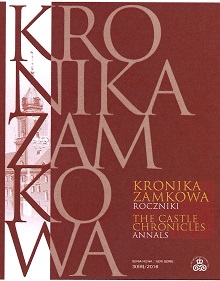Moda angielska na obrazach Canaletta z okresu polskiego 1767-1780.
English fashion in the paintings of Bellotto during his Polish period 1767-1780.
Author(s): Magdalena BialicSubject(s): Fine Arts / Performing Arts, History of Art
Published by: Arx Regia® Wydawnictwo Zamku Królewskiego w Warszawie – Muzeum
Keywords: Anglomania; Bellotto; tail coat; inhabitants of Warsaw; fashion; Enlightenment; portrait; clothing; street; Warsaw; vedute
Summary/Abstract: The cityscapes or vedute of Warsaw painted by Bernardo Bellotto (also called Canaletto, after his uncle) are an invaluable source of information about the lives of the city’s former inhabitants because, in principle, they portray representatives of all the social classes of that time. When painting his vedute of Warsaw, Bellotto also paid a great deal of attention to faithfully rendering the clothing of the protagonists of his paintings. Thanks to this, these paintings are a very valuable iconographic source for people who study costumes because they show the diversity of the fashions of eighteenth-century Warsaw. Irena Główczewska wrote about the clothing depicted in Bellotto’s paintings of Warsaw, including that in the French style. As well as the elaborate, courtly style which originated in France, the artist’s vedute also show examples of English clothing, which started to become popular in Poland and was one of the manifestations of Anglomania. Nearly all of Bellotto’s views of Warsaw depict figures dressed in the English fashion—mostly men wearing frock coats, tail coats, breeches, beaver hats and so-called top- boots (with high black bootlegs and lighter-shaded tops). People thus attired appear in such paintings as: Senatorska Street (1779), Mniszech Palace (1779), Długa Street (1777), Church of the Carmelites (1780) and View of Krakowskie Przedmieście Street from the Zygmunt III Column (1767/1768). The famous View of Warsaw from the Praga District (1770), on which Bellotto and his son, Lorenz, are visible, is also evidence that both the master himself and members of his family were adherents of the practical and relatively inexpensive English fashion—in this case, tail coats. In several of Bellotto’s vedute—for example Krakowskie Przedmieście Street Looking towards the Zygmunt III Column (1774)—one can also discern English clothing for children, which at that time was something revolutionary and very progressive. Some of Bellotto’s paintings, e.g. View of Wilanów Meadows (1775) and View of Warsaw with the Ordynacki Palace (1772), depict interesting items of sportswear in the English style (for hunting and horseriding), both for women (the riding habit of Maria Teresa Poniatowska) and for men. Bellotto’s vedute depict fewer examples of English fashion for women. On some of the paintings, including Iron Gate Square (1779) and Blue Palace (1779), there are interesting combinations of elements of French (dresses) and English (bonnets) fashions. This vast array of costumes in the English style in Bellotto’s paintings of Warsaw is proof of the fashion’s extraordinary popularity among Varsovians at that time—in particular among the middle classes and representatives of the so-called ‘free professions’. This phenomenon was spurred on not only by the spread of Anglomania in Europe, but also by economic and political factors.
Journal: Kronika Zamkowa. Roczniki
- Issue Year: 3/2016
- Issue No: 3
- Page Range: 179-202
- Page Count: 24
- Language: Polish

